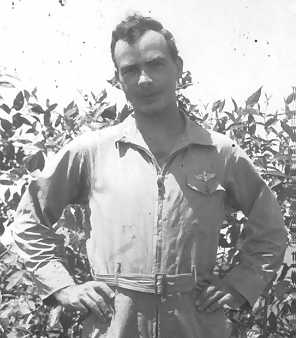Colonel Charles H.
MacDonald
![]()
 Charles Henry
MacDonald was born in DuBois, Pennsylvania, and graduated from Louisiana State University
in 1938. While at school, he developed an interest in becoming a pilot, and passed the
required exams for flight training. After graduation, MacDonald went to flight training at
Randolph and Kelly Fields in Texas. After finishing training, he was assigned to the 20th
Pursuit Group at Barksdale Field in Louisiana, flying P-36's. His group was later assigned
duty in Hawaii in February 1941. The P-36's were loaded onto the Enterprise and the
20th sailed to Hawaii. MacDonald had a unique experience for an Army pilot, he had to
takeoff from the carrier and land his plane in Hawaii. MacDonald was present for the
attack on Pearl Harbor, and managed to get airborne, although only after the attack was
over. After flying patrol for an hour and a half, MacDonald and his small group of planes
headed back to Hawaii, but encountered a fierce hail of flak from nervous and shaken
gunners. MacDonald had to run the gauntlet in order to land his aircraft. He remained in
Hawaii until early 1943, and was sent back to the United States to help train a P-47
squadron in Massachusetts. Charles Henry
MacDonald was born in DuBois, Pennsylvania, and graduated from Louisiana State University
in 1938. While at school, he developed an interest in becoming a pilot, and passed the
required exams for flight training. After graduation, MacDonald went to flight training at
Randolph and Kelly Fields in Texas. After finishing training, he was assigned to the 20th
Pursuit Group at Barksdale Field in Louisiana, flying P-36's. His group was later assigned
duty in Hawaii in February 1941. The P-36's were loaded onto the Enterprise and the
20th sailed to Hawaii. MacDonald had a unique experience for an Army pilot, he had to
takeoff from the carrier and land his plane in Hawaii. MacDonald was present for the
attack on Pearl Harbor, and managed to get airborne, although only after the attack was
over. After flying patrol for an hour and a half, MacDonald and his small group of planes
headed back to Hawaii, but encountered a fierce hail of flak from nervous and shaken
gunners. MacDonald had to run the gauntlet in order to land his aircraft. He remained in
Hawaii until early 1943, and was sent back to the United States to help train a P-47
squadron in Massachusetts. In June, 1943, MacDonald was stationed at New Guinea with the 348th Fighter Group. This assignment proved to be uneventful. He spent several months flying P-47's in escort patrols for transports in the Marilinan area. MacDonald was recruited to join the 475th Fighter Group, which was the first all-P-38 Lightning equipped group in the Fifth Air Force, by General George Kenney. By May 14, 1943, the 475th came into existence at Amberly Field, Australia. The group spent three months preparing for combat, then headed out New Guinea. The 475th proved to be a very effective unit through a 6:1 kill ratio throughout August. On October 15, 1943, radar warnings informed controllers that a large force of enemy aircraft was moving towards the Allied base at Dobodure. MacDonald and fifty other P-38's rose to meet the Japanese aircraft. MacDonald raced ahead and pressed an attack on seven Val dive bombers. He quickly downed two Vals, and was concentrating on a third when he was hit hard by a Zeke who slipped in behind him unnoticed. With loss of hydraulic pressure, MacDonald had to "belly in". Although he was not hurt, he had learned a valuable lesson. During the course of the battle, the 475th shot down 36 enemy aircraft without the loss of a single P-38! Macdonald was soon replaced George Prentice, who was being sent home as group commander. An October 25th mission to Rabaul demonstrated MacDonalds superb leadership abilities. He was leading a formation of P-38's flying escort on some B-24's sent to strike Rabaul. The weather turned bad, and all P-38's, except MacDonald's flight, turned back. Suddenly, the weather cleared and the formation of B-24's, with hardly an escort, was attacked by Zeros. MacDonald and his flight fiercely attacked the Zeros, and prevented many B-24's from being shot down. For his actions, Lt. Colonel MacDonald was awarded the Distinguished Service Cross. In 1944, General Kenney arranged for Charles A. Lindbergh to visit and fly with the 475th. He was able to teach the P-38 pilots to increase their operational range by 50%. During his stay with the 475th, he and MacDonald became good friends, and earned MacDonald's respect as an excellent pilot. On one interesting mission on July 28, 1944, he flew on an apparent "milk run" with MacDonald. However, this "uneventful" mission became a sticky situation for both MacDonald and Lindbergh. One Japanese fighter broke through the P-38's and set his sights on Lindbergh's P-38. They were on a collision course, both with guns blazing, when at the last moment, Lindbergh pulled up, and the wounded Japanese fighter could not follow and dove into the sea. MacDonald was put on "punitive leave" by General Paul Wurtsmith for allowing Lindbergh to get into a dangerous situation and went home for a month. MacDonald later returned to duty and spent the remainder of the war flying against the Japanese, and raised his score to twenty-seven in all. MacDonald was one of those rare people who were able to lead, command, teach, and inspire at the same time. |